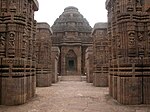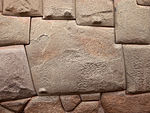Corbel arch


A corbel arch (or corbeled / corbelled arch) is an arch-like construction method that uses the architectural technique of corbeling to span a space or void in a structure, such as an entranceway in a wall or as the span of a bridge. A corbel vault uses this technique to support the superstructure of a building's roof.
A corbel arch is constructed by offsetting successive horizontal courses of stone (or brick) beginning at the springline of the walls (the point at which the walls break off from verticality to form an arc toward the apex at the archway's center) so that they project towards the archway's center from each supporting side, until the courses meet at the apex of the archway (often the last gap is bridged with a flat stone). For a corbeled vault covering, the technique is extended in three dimensions along the lengths of two opposing walls.
Although an improvement in load-bearing efficiency over the
Corbel arches and vaults require significantly thickened walls and an abutment of other stone or fill to counteract the effects of gravity, which otherwise would tend to collapse each side of the archway inwards.[citation needed]
Some arches use a stepped style, keeping the block faces rectangular, while other form or select them to give the arch smooth edges, usually with a pointed shape.
Use in historical cultures
Corbelling is a technique first applied by the ancient Egyptians and Chaldeans.[1]
Ireland
The Newgrange passage tomb, built sometime between 3200 and 2500 BC during the Neolithic period, has an intact corbel arch (vault) supporting the roof of the main chamber.[citation needed]
The medieval buildings of the monastery at Skellig Michael are also constructed using this method.[citation needed]
Ancient Egypt
During the
Ancient Mediterranean (Near East, Europe)
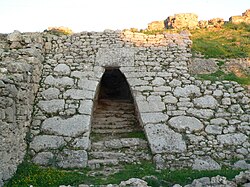
Corbel arches and vaults are found in various places around the ancient Mediterranean. In particular, corbelled burial vaults constructed below the floor are found in Middle Bronze II-III Ebla in Syria, and in Tell el-Ajjul, Hazor, Megiddo and Ta'anach in Canaan (today's Israel and Palestine).[3] Ugarit, an ancient port city in northern Syria, also has corbelled structures.[citation needed]
Hittites (Anatolia)
The Hittites in ancient Anatolia were also building corbelled vaults. The earliest ones date to the 16th century BC.
Some similarities are found between the Hittite and Mycenaean construction techniques. Yet the Hittite corbelled vaults are earlier by about 300 years.[4]
Greece (Mycenaean, Classical, Hellenistic)

Greece has a long list of surviving or archaeologically studied corbelled arches and vaults used for bridges and a multitude of other structures, dating from the
The ruins of ancient
The well-preserved Hellenistic Eleutherna Bridge on Crete has an unusually large span of nearly 4 metres.[6] A second nearby bridge, which had survived until the late 19th century, is tentatively dated to the late Classical period.[6]
Maya civilization
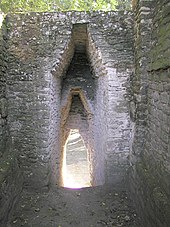
Corbeled arches are a distinctive feature of certain
India

Before the true arch was introduced in
The earliest large buildings of the
It took almost a century from the start of the
Indonesia
The candi or temples of Indonesia which were constructed between 8th to 15th century, made use of corbel arch technique to create a span opening for gate or inner chamber of the temple. The notable example of corbel arch in Indonesian classic temple architecture are the arches of Borobudur. The interlocking andesite stone blocks creating the corbel arch, are notable for their "T" formed lock on the center top of the corbel arch.
Cambodia
All the temples in Angkor made use of the corbel arch, between the AD 9th and 12th centuries.
Gallery
-
Arches at Nuraghe Santu Antine, Sardinia, 19-18th centuries BC
-
Doorway of Indo-Parthian Buddhist monastery at Takht-i-Bahi, Pakistan, c. 3rd century AD
-
Stone corbelled arches at Borobudur (9th century AD) in Java, Indonesia. Note the T-shaped central stones.
-
Brickwork corbelled arch atBali, Indonesia
-
The corbel span of Spean Praptos, 12th-century Cambodia
-
Stone corbelled gateway arch to walls of Angkor Thom (12th-17th c. city) in Cambodia
-
Stone corbelled arch in the 13th-centuryKonark temple, India
-
Screen of the Adhai Din Ka Jhonpra mosque (c. 1229), Ajmer, India; Corbel arches, some cusped.
-
Mausoleum of Iltutmish, Delhi, by 1236, early Indo-Islamic architecture
See also
References
- ^ Nakassis (2000), p. 364
- ^ Wilkinson, John Gardner, The Architecture of Ancient Egypt; ... with Remarks on the Early Progress of Architecture, Etc, 1850, Internet Archive
- ^ Suzanne Richard (2003), Near Eastern Archaeology: A Reader.
- ^ Maner, Ç. (2012), Corbelled Vaults in Hittite and Mycenaean Fortification Architecture
- ^ Nakassis(2000), pp. 363–364
- ^ S2CID 112648240. Retrieved 25 August 2020.
- ^ Coe (1987), p.65.
- ^ Michael Edwardes, Indian Temples and Palaces, London: Hamlyn, 1969, p. 95.
- ^ Harle, 421-425
- ^ Harle, 425
- ISBN 0-500-27455-X.
- Harle, J.C., The Art and Architecture of the Indian Subcontinent, 2nd edn. 1994, Yale University Press Pelican History of Art, ISBN 0300062176

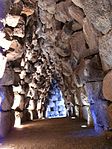
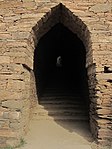


![Brickwork corbelled arch at Ubud[clarification needed Where?] in Bali, Indonesia](http://upload.wikimedia.org/wikipedia/commons/thumb/1/1f/Billbee-ubud.jpg/127px-Billbee-ubud.jpg)



